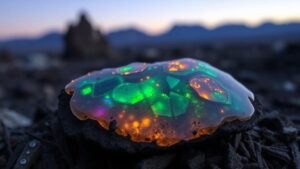Exploring gypsum flats near the White Sands National Park for selenite crystals and unique desert formations.
Exploring Gypsum Flats Near White Sands National Park for Selenite Crystals and Unique Desert Formations
Located in southern New Mexico, the gypsum flats adjacent to the White Sands National Park offer an extraordinary opportunity for rockhounds and mineral collectors. These unique landscapes are not only visually stunning but also host a variety of mineral specimens, particularly the striking selenite crystals. This article explores the geographical features, mineralogical significance, and practical tips for collectors who wish to delve into this fascinating area.
Understanding the Geological Context
The gypsum flats in the region are part of the larger Tularosa Basin, which showcases some of the worlds largest gypsum dune fields. Geologically, gypsum is a soft sulfate mineral composed of calcium sulfate dihydrate (CaSO₄·2H₂O). The formation of these flats can be attributed to the evaporation of ancient seas, leaving behind layers of sediment that have crystallized over time.
The White Sands National Park itself covers approximately 275 square miles and features over 25 square miles of pure white gypsum sand dunes. This environment supports the formation of selenite, a transparent crystalline variety of gypsum that can appear in various forms, including fibrous, tabular, and massive.
Identifying Selenite Crystals
Selenite is particularly prized among mineral collectors due to its beauty and rarity. This crystal can range in color from colorless to shades of white, grey, or even green, depending on impurities. Some key characteristics to look for when identifying selenite include:
- Transparency and clarity – The best specimens are clear and free from inclusions.
- Cleavage – Selenite has perfect cleavage in one direction, which can help differentiate it from other similar minerals.
- Hardness – It has a Mohs hardness of 2, which makes it softer than many other crystals.
When searching for selenite specimens, locations where evaporation has occurred are ideal. Look for areas with exposed gypsum rock, shallow depressions, and the bases of sand dunes where the selenite may have been unearthed by erosion.
Unique Desert Formations
Beyond selenite, the gypsum flats feature an array of unique geological formations. Some noteworthy formations and features include:
- Shield formations: These are flat-topped hills that resemble enormous basalt structures and are composed of sintered gypsum.
- Crystal encrustations: Look for areas where selenite has formed beautiful clusters and fan shapes.
- Natural sculptures: The interplay of erosion and wind has sculpted the gypsum into fascinating shapes that invite exploration and photography.
Best Practices for Collecting
While exploring and collecting selenite crystals, its crucial to follow responsible collecting practices to preserve the natural environment. Here are a few tips:
- Seek permission where required: While many areas around White Sands are publicly accessible, ensure you are not collecting from protected lands.
- Limit your impact: Stick to established paths to minimize disruption to the local flora and fauna.
- Take only what you can use: Harvest responsibly, and take only a few specimens to ensure sustainability for future collectors.
- Tools of the trade: Equip yourself with a geological hammer, safety goggles, and a sturdy backpack for transporting your finds.
Real-World Applications
Collecting selenite and other minerals has implications beyond personal interest and aesthetic appeal. Selenite is often used in:
- Construction: Gypsum is a primary ingredient in drywall production, making it an essential component in building materials.
- Collectibles and jewelry: Polished selenite is prized for ornamental use, from decorative pieces to unique jewelry making.
- Spiritual practices: Many practitioners in holistic and spiritual communities utilize selenite for its purported healing properties.
Actionable Takeaways
Exploring the gypsum flats near White Sands National Park offers mineral enthusiasts countless opportunities to discover selenite crystals and observe unique desert formations. By understanding the geological context, identifying key mineral characteristics, practicing responsible collection, and recognizing the broader applications of these minerals, you will enrich your collecting experience. Always ensure to respect the natural environment during your adventures, so future generations of rockhounds can enjoy the beauty of these remarkable landscapes.


